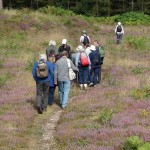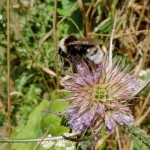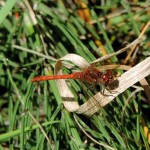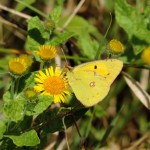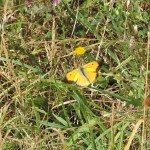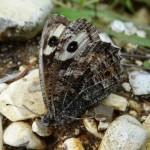On Wednesday 20th August, Jan Haseler led a circular walk round the conifer plantations to the west of Mortimer. The walk started at the south-east corner of Holden’s Firs, where the group of Bronze Age round barrows is one of the finest surviving examples of a small barrow cemetery in Berkshire. The barrow clearing was carpeted by flowering Ling and Bell Heather, with Dwarf Gorse and Musk Mallow also seen here. Continuing along the tracks through the plantation, one of the puddles had a mixture of a Water-starwort, with leaves flat on the water surface, and Water Purslane, with leaves standing up out of the water.
The route continued along a wide ride through Hundred Acre Piece. Flowers in the ride margins included Common Fleabane, Water Mint, Blue Fleabane, Common Bird’s-foot-trefoil, Red Bartsia and Goat’s-rue. A Clouded Yellow butterfly paused to nectar on Common Fleabane before flying off along the ride. Other butterfly species seen were Common Blue, Small White, Gatekeeper, Meadow Brown, Red Admiral, Comma, Small Tortoiseshell and Brown Argus. A pale cuckoo bumblebee was nectaring on a Wild Teasel flower and a number of dragonflies were seen, but only Common Blue Damselfly and Common Darter were identified. The track towards the western boundary of the plantation was bare and stony and this is where the first of the Grayling butterflies was seen. It landed on the path, closed its wings, briefly showed the pale yellow band with eye spots on the forewing, then tucked its forewings behind its hindwings and vanished, as its cryptically-patterned grey-brown hindwings blended into the stony background. Beyond the western boundary are recent gravel workings and this is where the group had splendid views of a hunting Hobby. Two more Graylings were found here. The return route followed a shady path through a damper stretch of plantation, with a stand of Great Horsetail beside the path. The last Grayling was found in another open, stony section. The group watched it as it closed its wings, shuffled round until it was broad-side on to the sun and then leaned over to maximise its exposure to the sunlight. It then fluttered a short distance to the side of the path and walked around, investigating clumps of fine grasses. The final section of the route led past a dammed lake with White Water-lilies and Broad-leaved Pondweed. The walk was followed by lunch at the Calleva Arms in Silchester.
Pictures by Rob Stallard and Laurie Haseler

